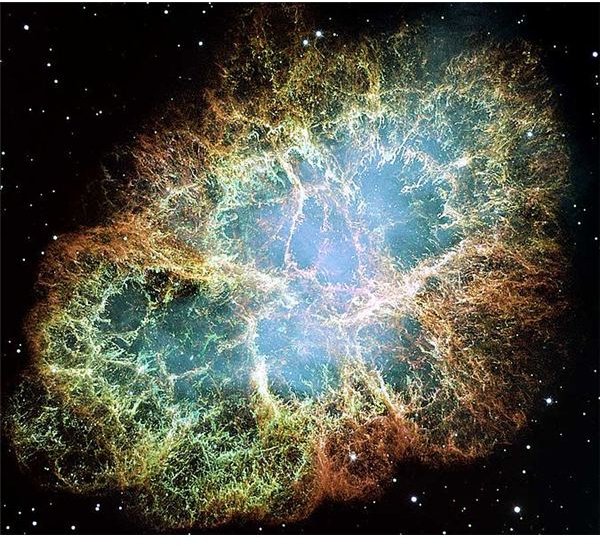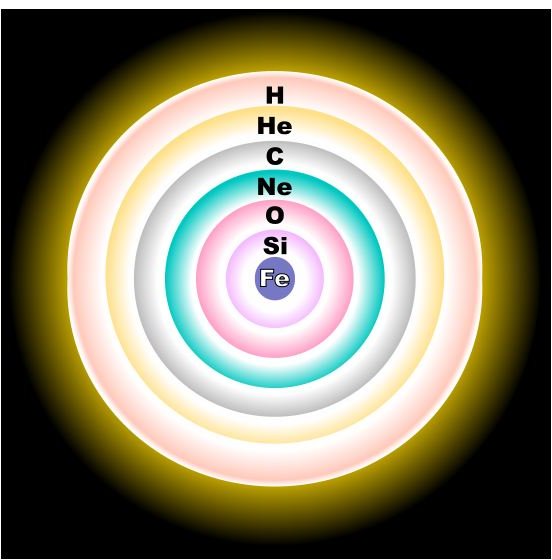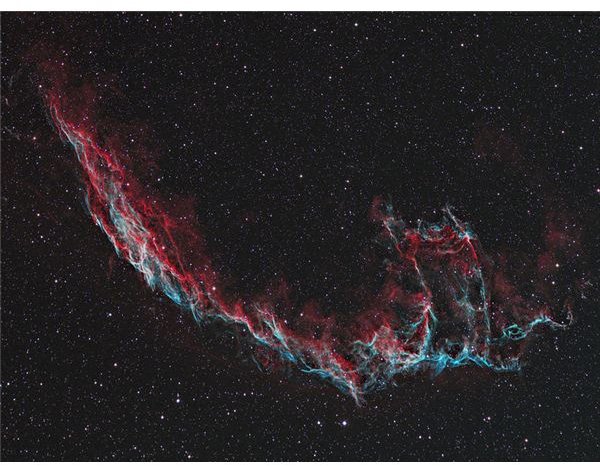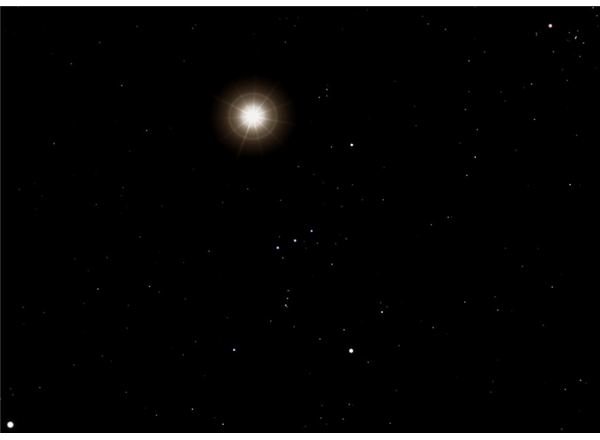Supernova Remnants: The Broken Bodies of Stars
What is a Supernova?

Simply, it is an exploding star. This is where the delicate equilibrium between gravity and the star’s inner fire is disrupted. In moments, the temperature hurtles upward, blowing the star apart.
There are several types of supernovae, but two types predominate—critically massive white dwarfs, and very old and massive stars (those which start with a mass greater than about nine times that of our own Sun).
For the white dwarf sources, additional mass may come from the accretion of a nearby neighbor (a star which perhaps had become a red giant after the white dwarf had been one), or from two white dwarfs merging. The additional mass causes the white dwarf to push inwardly with greater gravitational force. Before collapse can occur, carbon fusion is initiated causing a substantial portion of the star to ignite. Moments later, the star cannot contain the new gargantuan wave of heat and it explodes.
Far heavier stars—those exceeding about nine solar masses—undergo several stages of fuel burning. During the star’s main sequence, hydrogen in the core is turned into helium and helium adds nothing to the fire. When the core runs out of hydrogen, the inert helium stands dumbly by while the star starts to collapse. Equilibrium has been upset; gravity takes over. But before gravity can get very far, helium ignites, burning at a far higher temperature, fusing to become carbon. This pushes the outer body and atmosphere of the star farther out and the star becomes a red giant. The term “red” is not literal, but merely means that the visible star is cooler or closer to the red end of the spectrum than it was during the main sequence. Above this helium-burning core, the temperatures are hot enough for the hydrogen there to ignite, creating even more helium.
Stellar Life Beyond Hydrogen

After the helium fuel in the core becomes depleted, the star once again collapses, soon igniting the carbon. The process continues with shells of burning hydrogen, helium, carbon, neon, oxygen and silicon. Each stage burns more quickly and in turn depletes its fuel and collapses the star. Other elements are created and they participate in the overall milieu of nuclear soup.
The final core of iron is the stopping point. Up to iron, combining elements release energy. Above iron on the periodic table, fusing elements would absorb energy, greatly cooling the core of the star. However, the opposite occurs in a supernova. Iron is split (fission) by the greatly increasing heat from gravitational collapse. Fission of iron to lighter elements also absorbs vast amounts of energy, accelerating the collapse.
The final collapse becomes a runaway train hurtling toward the core at speeds approaching 70,000 km/second (roughly one-fourth light speed). Scientists still do not thoroughly understand what happens in the core, but the fierce energies at work trigger an explosion that outshines much of the galaxy.
The bulk of the star is spewed outward and this becomes the most visible part of the supernova remnant. This becomes a bright nebula. At the center of this nebula resides either a neutron star or black hole.
Remnant Size
Naturally, size of a supernova-generated nebula will depend on its age. A fresh one will be anywhere from a few light-minutes across to about a light-day across—that’s from about one AU or so (astronomical units—a unit based on the distance from Earth to the Sun) to about 80 AU’s. And, even at this great size, the envelope of expanding gas continues to move outward at its screaming pace.
As the shockwave progresses outward from the center of the explosion, it meets with and is greatly slowed by the interstellar medium. This enveloped rarified gas is greatly heated, but rapidly cools, radiating away the excess energy. Where the shockwave encounters greater density in the interstellar medium, the force of compression squeezes these regions creating visible filaments billions, and sometimes trillions, of kilometers long. The radius of this visible shell can be more than a hundred light years across.
Such a volume of space would encompass tens of thousands of stars. From this it is easy to appreciate the powerful effect a supernova might have in your neighborhood.
After several hundred thousand years, the remnant dissipates and cools to the point that it is no longer visible. Along the way, though, the shock of the remnant pounding on nearby nebulae stimulate the compression and collapse that results in the birth of new star systems.
Speed and Composition

A supernova lets loose of its stellar envelope at something like 10,000 km/second, or about three percent of light speed. Three percent may not seem like much, but light travels awfully fast. Imagine traveling from New York to Tokyo in one second. That’s how fast a supernova explodes. In fact, the maximum speed of a remnant is about 30,000 km/second, or ten percent of the speed of light. As the expanding remnant of the former star interacts with the interstellar medium the speed decreases over thousands of years to a mere few tens of kilometers per second.
Supernovae generate iron and all heavier, naturally occurring elements. Without supernovae in our past, Earth and life as we know it would not have been possible.
Examples of Supernovae Visible Today
- Veil Nebula (Cygnus Loop) — distance: 1,470 light years, diameter: 100 light years, age: 6,500 (±1,500) years.
- Simeis 147 — distance: 3,000 (±350) light years, diameter: 137 (±25) light years, age: 40,000 years.
- SN 1987a (in Tarantula Nebula, Large Magellanic Cloud) — distance: 168,000 light years, diameter: 1.8 light years, age: 24 years.
- Crab Nebula (SN 1054 in Taurus) — distance: 6,500 light years, diameter: 11 light years, age: ~1,000 years.
Future Supernovae

Based on the number of supernova-generated nebulae, astronomers estimate that a supernova occurs roughly once every half century in the Milky Way galaxy. The last known supernova to have occurred in our own home galaxy brightened the night skies of Johannes Kepler in 1604, a mere 32 years after Tycho’s supernova (click to see image).
Recent news that Betelgeuse had started to collapse generated a great deal of speculation that this brightest star in Orion might go supernova, soon. Scientists have long predicted that it might do this in the next million years or so. But Betelgeuse might brighten up the day-time sky in our own lifetimes as a type II supernova.
The supernova will likely be harmless to life on Earth because of the star’s great distance and because the pole of rotation is pointing away from Earth—sparing us the greatest portion of gamma ray emission.
Because the great distance and the fact that Betelgeuse is receding from us at about 22 km/second, the remnant will never reach Earth before dissipating into harmless gas and dust.
IK Pegasi is the closest known candidate for a future supernova, though a great deal will have to transpire before that happens. This system is a binary with a bright A8 main sequence star and a white dwarf orbiting each other every 21.7 days. In the future, when the A8 primary star runs out of hydrogen and evolves into a red giant, its outer envelope will be pulled onto the surface of the white dwarf, greatly increasing the mass of that degenerate body.
When that mass approaches the Chandrasekhar limit of about 1.44 solar masses, and if the star is a carbon-oxygen white dwarf, it will explode as a type I supernova. In the nearly million years it might take for these things to happen, IK Pegasi will have moved a few hundred light years farther away, greatly reducing any impact it will have on Earth’s biosphere. And, like Betelgeuse, the future IK Pegasi remnant will not pose a hazard to our tiny planet.
Image Credits
Photograph of Crab Nebula provided by NASA (public domain).
Evolved star fusion shells graphic image by Rursus, provided by Wikipedia.
Bicolor Ha/OIII photograph of Eastern Veil Nebula provided by Hewholooks, courtesy Wikipedia.
Simulated Betelgeuse supernova from a screenshot of Celestia software by HeNRyKus, courtesy Wikipedia.
References
- Shklovskii, Iosif, Stars: Their Birth, Life, and Death. W. H. Freeman and Company, 1978.
- “Simeis 147,” http://en.wikipedia.org/wiki/Simeis_147
- “IK Pegasi,” http://en.wikipedia.org/wiki/IK_Pegasi
- “Supernova,” http://en.wikipedia.org/wiki/Supernova
- “Crab Nebula,” http://en.wikipedia.org/wiki/Crab_Nebula
- “List of Supernova Remnants,” http://en.wikipedia.org/wiki/List_of_supernova_remnants
- “Betelgeuse,” http://en.wikipedia.org/wiki/Betelgeuse
- “SN 1987A,” http://en.wikipedia.org/wiki/SN_1987A
- “SN 1054,” http://en.wikipedia.org/wiki/SN_1054
- “Veil Nebula,” http://en.wikipedia.org/wiki/Veil_Nebula